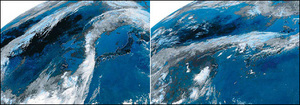The weather has been fickle this month and will continue that way. It had been scorching for some time when on Monday the weather suddenly changed. Torrential downpours lasted 10 to 20 minutes in many regions including Seoul and Cheolwon, Gangwon Province, with rain stopping and starting repeatedly. The Korea Meteorological Administration (KMA) on Monday said similar showers with thunder and lightening are expected in Chungcheong Province and southern parts of Korea on Tuesday.
Two major reasons are cited for the unexpected weather changes. A hot and humid North Pacific anticyclone collided with cold air from China and that made air above Korean peninsular unstable, causing the fickle weather, the KMA said. Experts also pointed to an abnormal cloud belt that formed in the air above the Korean Peninsula.

|
| ©Unknown
|
| Satellite picture of sky in East Asia by Japanese weather satellite NTSAT. The ordinary east-west cloud belt is seen in the picture taken on Aug. 27, while clouds are stretched north-south in the picture on Aug. 14.
|
"The most extraordinary phenomenon this summer was that the cloud belt aligned north-south instead of east-west," said Prof. Ho Chang-hoi at the School of Earth and Environmental Sciences of Seoul National University. The reason was a massive inflow of hot and humid air from subtropical regions while the rim of North Pacific anticyclone was aligned north-south. "The fact that hot air from the equator flowed into the Korean Peninsula indicates that the climate in Korea is now becoming subtropical."
In Seoul, it rained almost every day in early and mid-August, but the average temperature until Aug. 26 was counter-intuitively one degree Celsius higher than the previous year. Chung Yong-seung, director of the Korea Atmospheric Environment Institute, said, "Another unusual weather phenomenon is that it has rained often but the precipitation in this summer was less than last year."
That has also meant an increase the number of "tropical nights", when the nocturnal low does not fall below 25 degrees. In Seoul, as of Sunday, there had been 11 tropical nights in August, four times more than the average number of 3.2, between 1971 and 2000. In Daegu, there were a whopping 15 tropical nights, up from the average 4.2, and in Seogwipo 23 while the average was 10.8. In addition, experts said it rained more in early August than in the actual rainy season, and the average temperature was higher in the end of August than the middle of the month.

The Ultimate Weapon of Mass Destruction: "Owning the Weather" for Military Use by Michel Chossudovsky [Link]